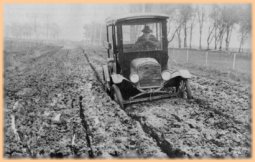

| A Brief History | |
| · | Origins |
| · | Picking a Route |
| · | From Dirt To Concrete |
| · | The End of Named Highways |
| Historic Newspaper Articles | |
| · | Highway Boosters Will Gather Tonight San Francisco Chronicle; October 31, 1913 |
| · | Public To See Dedication of Great Highway San Francisco Examiner; October 31, 1913 |
| · | Plans for Local Demonstration Under Way San Francisco Chronicle; October 26, 1913 |

In 1912, there were almost no good roads to speak of in the United States. The relatively few miles of improved road were only around towns and cities. A road was "improved" if it was graded; one was lucky to have gravel or brick. Asphalt and concrete were yet to come. Most of the 2.5 million miles of roads were just dirt: bumpy and dusty in dry weather, impassable in wet weather. Worse yet, the roads didn't really lead anywhere. They spread out aimlessly from the center of the settlement. To get from one settlement to another, it was much easier to take the train.

Carl Fisher recognized this situation, and an idea started to take
hold. Fisher was a man of ideas. As soon as he thought of a project and
got it started, he would grow restless and start on another one. His
Indianapolis Motor Speedway was a success, especially after he paved it
with brick and started the Indianapolis 500, and he would later turn a
swamp into one of the greatest beach resorts: Miami Beach, Florida.
However, in 1912, he dreamed of another grand idea: a highway spanning the
continent, from coast to coast.
He called his idea the Coast-to-Coast Rock Highway. The gravelled road would cost about ten million dollars, low even for 1912. Communities along the route would provide the equipment and in return would receive free materials and a place along America's first transcontinental highway. The highway would be finished in time for the 1915 Panama-Pacific Exposition and would run from the exposition's host, San Francisco, to New York City.
To fund this scheme, he asked for cash donations from auto manufacturers and accessory companies of 1 percent of their revenues. The public could become members of the highway organization for five dollars.
Fisher knew that success of the ten-million dollar fund would depend on the support of Henry Ford. Unfortunately, even after many persuasive attempts by friends and close associates, Ford would not support the project. The public would never learn to fund good roads if private industry did it for them, he reasoned. This put the fund in jeopardy; there would not be enough time or money to finish the highway by the exposition in 1915. However, now that the country had become so enthusiastic about the highway, Fisher would not give up. Two men from the automobile industry who pledged money to Fisher's idea would later play major roles in the highway's development: Frank Seiberling, president of Goodyear, and Henry Joy, president of the Packard Motor Car Company.

Henry Joy came up with the idea of naming the highway after Abraham
Lincoln. He wrote Fisher urging him to write a letter of protest to
Congress, which was considering spending $1.7 million on a marble memorial
to Lincoln. Joy thought a good road across the country would be a better
tribute to the president. The name "Lincoln" captured Fisher's fancy; he
realized it would give great patriotic appeal to the highway. Fisher asked
Joy if he wanted to be involved directly with the highway project. At
first, Joy was hesitant, but soon he wholeheartedly supported the
project and became the primary spokesman for the highway.
Last modified on October 7, 1998